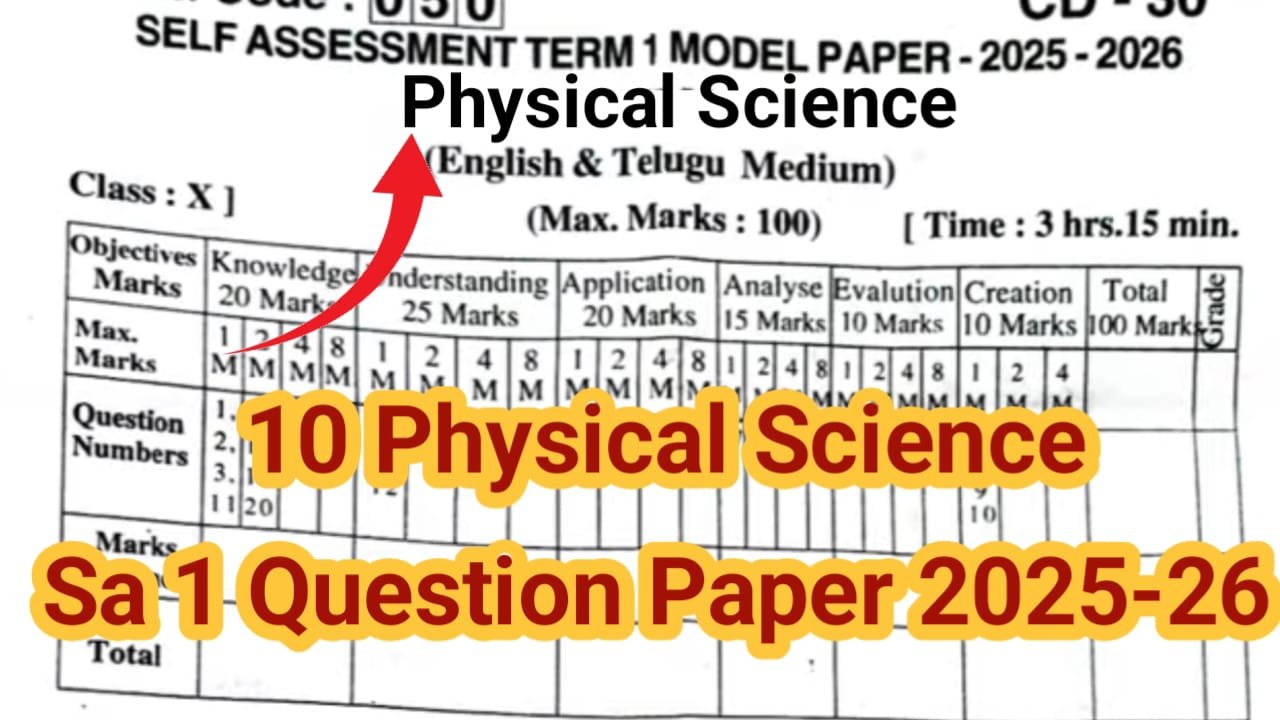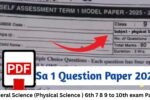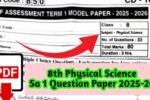ఆంధ్రప్రదేశ్ ప్రభుత్వం / Government of Andhra Pradesh
SELF-ASSESSMENT TERM-1 MODEL PAPER – 2025-26
Class : X Subject : General Science (Paper-1 – Physical Science)
UDISE Code : __________ PEN ID : __________ Roll No : __________
Time : 3 Hours Maximum Marks : 100
విభాగం-A / Section-A : బహుళ ఐచ్ఛిక ప్రశ్నలు / Multiple-Choice Questions
(Each question carries 1 mark – 20 × 1 = 20)
Choose the correct option and write the correct letter (A/B/C/D) in your answer sheet.
- SI unit of electric current —
A) Volt B) Ampere C) Ohm D) Watt - Relation between potential difference, current and resistance —
A) V = IR B) V = I/R C) I = VR D) P = VI - The work done when 1 coulomb of charge moves through 1 volt potential difference is —
A) 1 J B) 1 W C) 1 Ω D) 1 C - Rate of doing electrical work is called —
A) Power B) Energy C) Current D) Charge - Device converting chemical energy into electrical energy —
A) Motor B) Battery C) Generator D) Transformer - 1 kilowatt-hour (kWh) = ________ joules.
A) 360 J B) 3600 J C) 3.6 × 10⁶ J D) 3.6 × 10³ J - Ohm’s law states that —
A) V ∝ I B) I ∝ R C) V ∝ 1/I D) V = I²R - The resistivity of a conductor depends on —
A) Temperature B) Length only C) Cross-section only D) None - Magnetic field lines around a straight current-carrying conductor are —
A) Straight lines B) Circular C) Elliptical D) Radial - In Fleming’s Left-Hand Rule, the middle finger shows —
A) Force B) Current C) Magnetic Field D) None - Which one is an electromagnetic wave?
A) Sound B) X-ray C) Water wave D) Mechanical wave - The phenomenon of bending of light when it passes from one medium to another is —
A) Reflection B) Refraction C) Diffraction D) Dispersion - Refractive index of a medium is the ratio of —
A) Speed of light in air / speed in medium
B) Speed in medium / speed in air
C) Angle of incidence / angle of refraction
D) None - The focal length of a concave mirror is 10 cm. Its radius of curvature is —
A) 5 cm B) 10 cm C) 15 cm D) 20 cm - The mirror used in vehicles as rear-view mirror is —
A) Plane B) Concave C) Convex D) None - The heat required to raise the temperature of 1 g of a substance by 1°C is —
A) Latent heat B) Specific heat C) Thermal capacity D) Calorie - The process of changing solid directly into vapour —
A) Condensation B) Evaporation C) Sublimation D) Melting - The potential difference between two points when 1 J work is done to move 1 C charge —
A) 1 V B) 1 A C) 1 W D) 1 Ω - A device that converts electrical energy into mechanical energy —
A) Generator B) Motor C) Cell D) Transformer - SI unit of power —
A) Volt B) Joule C) Newton D) Watt
విభాగం-B / Section-B : సంక్షిప్త సమాధానాలు / Short-Answer Questions
(Each question carries 2 marks – 8 × 2 = 16)
- State Ohm’s Law and write its mathematical equation.
- Define electric power and write its units.
- Write two differences between series and parallel connection of resistors.
- Define specific heat. Give its SI unit.
- What are magnetic field lines? Write any two properties.
- What is reflection of light? State the laws of reflection.
- What is thermal expansion? Give one example.
- Write any two precautions to be taken while performing an experiment with electricity in laboratory.
విభాగం-C / Section-C : అన్వయ మరియు సంఖ్యాత్మక ప్రశ్నలు / Application & Numerical Problems
(Each question carries 4 marks – 6 × 4 = 24)
- Calculate the resistance of a conductor if a current of 2 A flows through it when potential difference is 12 V.
Find the resistance and write the formula used. - A bulb is rated 60 W, 220 V. Calculate the current drawn and resistance of the filament.
- A ray of light incident on a plane mirror at an angle of 30°. Find the angle of reflection. Draw a neat labelled diagram.
- Explain refraction of light through a rectangular glass slab with a neat diagram.
- Derive the formula for equivalent resistance when resistors are connected in parallel.
- Define specific latent heat. Explain the difference between latent heat of fusion and vaporization with examples.
విభాగం-D / Section-D : దీర్ఘ సమాధానాలు / Long-Answer Questions
(Each question carries 8 marks – 5 × 8 = 40)
- (a) Explain Joule’s Law of Heating.
(b) Describe any two applications of heating effect of electric current. - Describe the structure and working of an electric motor with a neat labelled diagram.
- Explain the image formation by a concave mirror for different positions of an object with ray diagrams.
- What is refraction through a prism?
Explain the formation of spectrum of white light through a prism with a neat labelled diagram. - Derive the relation between focal length (f), object distance (u) and image distance (v) for a spherical mirror.
🧾 ANSWER KEY / సమాధానాలు
Section-A (1 mark each):
1-B 2-A 3-A 4-A 5-B 6-C 7-A 8-A 9-B 10-B 11-B 12-B 13-A 14-D 15-C 16-B 17-C 18-A 19-B 20-D
Section-B (2 marks each – key points):
21. Ohm’s law: V ∝ I → V = IR.
22. Power = VI = I²R = V²/R; Unit – Watt.
23. Series: same current; total R increases. Parallel: same voltage; R decreases.
24. Specific heat = heat required to raise temp of 1 kg by 1°C; Unit J/kg°C.
25. Magnetic field lines: imaginary lines representing field; never intersect, continuous loops.
26. Reflection: bouncing of light; Laws – i = r; incident ray, reflected ray, normal lie on same plane.
27. Expansion of a body when heated; e.g., railway track gaps.
28. Switch off supply, use dry hands, insulated wires.
Section-C (4 marks each – hints):
29. R = V/I = 12/2 = 6 Ω.
30. I = P/V = 60/220 = 0.27 A; R = V/I = 220/0.27 ≈ 814 Ω.
31. Angle of reflection = angle of incidence = 30°.
32. Diagram showing lateral displacement; r₁, r₂ refraction.
33. 1/R = 1/R₁ + 1/R₂ + … ; derive using equal potential drop across each resistor.
34. Latent heat = heat energy for change of state without temperature change; fusion (ice→water), vaporization (water→steam).
Section-D (8 marks each – summary):
35. Joule’s law: H = I²Rt; applications – electric iron, heater, fuse.
36. Electric motor: armature, commutator, brushes, magnets; principle – force on current-carrying conductor in magnetic field; diagram.
37. Concave mirror images: beyond C (real, inverted, smaller), at C (same size), between C-F (bigger, real), at F (at infinity), between F-P (virtual, erect).
38. Prism refraction: white light splits into 7 colors due to dispersion; diagram with angle of deviation.
39. Mirror formula derivation: 1/f = 1/u + 1/v from similar triangles; sign convention table.


